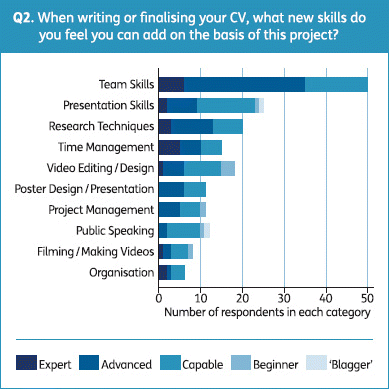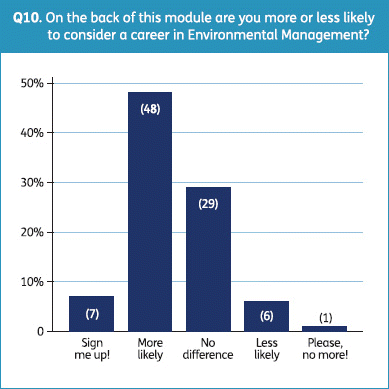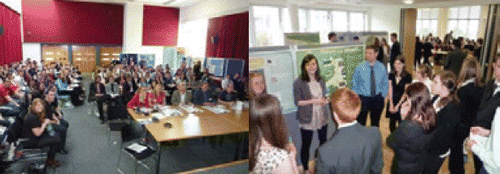Abstract
Through a new ‘pitch’ assessment, students studying a course on environmental management pitch competitively for a real-world grant at a ‘professional’ conference attended by local county council members. Student groups present their pitch through a combination of video, oral and poster presentations and supplementary documents. This paper describes the implementation of the pitch assessment within an existing large group module over a two-year period and proposes that GEES subjects are well suited to this type of assessment. The new assessment exposes students to the realities of environmental management while also encouraging students to engage with employability. Student evaluation suggests that the assessment was enjoyable, supported a range of learning styles, and successfully encouraged students to identify their relevant skills and experiences and directed them towards consideration of future career options. The assessment style is flexible and appropriate for a range of contexts within the GEES disciplines.
Background
The current economic and political climate, increased student numbers and concurrent competitiveness in the graduate recruitment sector have all encouraged universities to focus on embedding employability into degree schemes (CitationGedye, 2009). Employers often express dissatisfaction that graduates are not equipped with the types of skills and experience they want (CitationGedye and Chalkley, 2006), with CitationRobins and Gowar (2003) reporting that 70% of surveyed employers were unimpressed with graduate employability skills. Over three-quarters of employers suggested that improving graduate employability skills should be a key priority for universities (CitationCBI/UUK, 2009), while CitationLowden et al. (2011) found that some employers are frustrated that courses do not meet their needs. CitationKemp et al. (2008) identify a mismatch between student perceptions of acquired skills and employer expectations regarding skills such as time management, working under pressure, problem solving and the delivery of professional presentations. CitationKemp et al. (2008) also demonstrated that 75% of employers who valued an ability to bring in new business felt that this attribute was lacking in recent graduates.
Yet within the GEES disciplines, CitationHawksworth and Kneale (2001: 19) note that “GEES students are multi-talented and multi-skilled. The problem is that they have trouble acknowledging this”. They suggest that it takes considerable coaching and encouragement for students to identify these skills and that “almost all GEES students DO NOT present evidence for having these skills in their CVs, on their application forms and in their interviews” (ibid.). In this paper, I describe the development of a new assessment style implemented within an existing large group module that aims to encourage GEES students to recognise the requirements of employers and offers an opportunity to practise and demonstrate relevant employment-related competencies.
Assessment outline
The new assessment was implemented in 2010 and 2011 within a large (~150 students) Level two module entitled ‘Environmental Management’ at Aberystwyth University. The aim of the module is to expose students to some of the realities of undertaking a range of environmental management projects. The module is a core requirement for students studying Environmental Science and is taken as an optional module by students studying Geography, Physical Geography, and Environmental Earth Science degrees. In past years, students were divided into groups and assessed through two lengthy management reports. Student feedback pointed to insufficient distinction between the two reports, with students appearing to lack motivation for the second project.
In response to this feedback, the second report was replaced by an assessment where student groups ‘pitch’ for one of five grants at a ‘professional’ conference at the end of the module (). To put across their project pitch, student groups were allocated a five minute slot for a video presentation (2–3 minutes) and an oral presentation (also 2–3 minutes). Space for an A0 poster was provided at the conference venue and each group also had five sides of the conference handout to present specific details of their projects.
The five grants covered a range of environmental management projects each of which gave student groups a specific role (e.g. “You work for a private energy company”) and a client or awarding body (e.g. Forestry Commission Wales, Local Planning Authority). These are summarised briefly in . Clear instructions were given on what the ‘boss’ or line manager had requested although there was considerable scope for variation. Each project is based around a ‘real-world’ grant or contract currently available, though in some cases minor “tweaks” have been made (e.g. disregarding geographical or time restrictions). While these grants would not be awarded through such pitches, the projects are designed to make the most of this assessment style. A meeting with Ceredigion County Council was instrumental in the design of these projects, with two projects actually relating to ‘live’ applications.
Once each group presented on a particular project, time was allocated for questions at the posters. Students not competing for the same grant were designated ‘roles’ (e.g. environmental activist, Welsh Assembly Government representative) from which to question the other groups. To develop a sense of competition, a ‘popular vote’ was taken before the next grant was introduced. All attendees were encouraged to dress formally and act professionally during the conference and to enhance this effect, a real conference venue was booked. Two council members attended the conference and formed part of the panel, alongside other lecturers and staff from the careers service. They provided a thorough review of the projects, though neither council members nor students played any part in the final assessment.
Table 1: Brief summary of projects.
Final assessment criteria spanned four categories: fundamental/conceptual (weighted 35%, including the extent to which the project brief was met, completeness, appropriateness and creativity of proposals); technical (15%, including accuracy of content and analyses); structural and presentation (45%, covering each pitch component, e.g. poster design and layout, video storyboard, communication of message, etc.); and team coherence (5%, including professionalism).
The pitch assessment offers the students flexibility in learning as it comprises several components that must be allocated in a group situation. It is a pressurised, high-stakes assessment (CitationKnight and Yorke, 2006) and authentic in that it resembles students’ future professional practice (CitationGulikers et al., 2006). Alongside subject specific skills, these assessment methods test a broad range of transferable skills including team work, time management, attention to detail, budgeting (and identifying match-funding sources), initiative, script-writing, video filming, editing, poster design, verbal presentation, and oral defence of the project. Many of the required skills will be new to the student group taking this module, especially those related to video production. An instructional vodcast was created to support this element (alongside specific workshops on video production). The requirement to develop a completely new skill is included to assist the reflection process when, at the end of the module, students are required to focus on the skills they have acquired or developed over the course of the project.
Evaluation
Questionnaires were returned by 79% of module participants. Of the respondents, 87% enjoyed the assessment overall. In general, positive feedback emphasised the welcome variation of assessment style and the fact that the module offered something ‘different’ (as suggested by CitationBrown et al., 1995). The conference was very popular with students; 95% stated that they enjoyed the event. Dressing for the workplace had a remarkable effect on the students who, on the whole, acted professionally and engaged with each project. Many students appreciated that the projects were grounded in the ‘real world’. As one student wrote: “Different! Challenging, thought provoking, IT IS AN ALMOST ‘REAL’ PROJECT.” The range of tasks required of the groups was also seen as a positive aspect: “It’s varied, it allows everyone to flourish in their own field which they do well at. Groups work well — good module.”
The video element of the pitch seemed to polarise the students: the vast majority identified this as the highlight of the project, whereas others felt it to be an unwelcome and unnecessary burden. The instructional vodcast was downloaded 518 times and was thought to be useful by 78% of respondents; however, this support will be developed further with the participation of a local video producer in a workshop session. The video presentations improved markedly in the second year of the assessment, when specific examples of high-quality videos were provided.
When asked what they enjoyed least about the assessment style, the challenge of group work featured regularly. However, 85% of respondents stated that they enjoyed the experience of group work. The pressure of presenting to the council members was also highlighted as a main concern.
A camera was provided in a private room during the conference; video feedback was provided by eight students. This was entirely positive. One student commented: “I really enjoyed it. I thought it was really good. It’s better than any module I’ve done… except going to New Zealand. But it’s the best module in Aberystwyth by far.”
Following the conference, I received several emails from students. These were entirely unprompted and extremely positive: “Thank you for an interesting and motivating module! I really feel that yesterday aided myself (and I’m sure everyone else in the room) in developing ‘real world’ skills. I felt a great sense of achievement, and personally felt very professional! I just wish more modules were the same.” I was asked to provide a copy of a presentation (which we recorded) for a student to show his parents! In 2011, one parent even attended the conference (rather unexpectedly).
Competency-based questions
The aim of this assessment is to encourage students to engage more with employability issues. Thus, in the post-module questionnaire, competency-based questions were included to encourage reflection on the process they experienced and identify skills they feel they developed. They were asked: ‘When writing or finalising your CV next year, what new skills do you feel you can add on the back of this assessment?’ A blank table was provided for respondents to identify a specific skill and a level of competency (1–5 representing ‘Blagger’ to ‘Expert’). It is encouraging that many of the skills that students felt that they acquired to a high skill level also appear on CitationBrennan et al.’s (2001) list of skills required in current employment in the UK and on the list of common graduate shortfalls (CitationGedye and Chalkley, 2006; CitationCBI/UUK, 2009). These include team skills, presentation skills, time management, project management, public speaking and organisation. The top ten skills are shown in where the frequency of responses is broken down by skill level. This demonstrates the number of cases where students feel they have highly developed team skills; though the experience of CitationKemp et al. (2008) suggests that employers often judge to harsher standards. This is particularly important as 60% of respondents suggested that they are more likely to pursue a career in Environmental Management after taking this module ().
Figure 2: Result of the competency-based questions. “When writing or finalising your CV next year, what new skills do you feel you can add on the back of this assessment?”. The top ten skills are ranked based on both frequency of responses and skill level (i.e. the sum of skill ratings).

Figure 3: Responses to: “On the back of this module are you more or less likely to consider a career in environmental management?” Numbers in parentheses indicate absolute values.

Since ‘self assessment’ of key skills abilities does not always provide a reliable reflection of strengths and weaknesses, it is relevant to note that the council members present at the conference were also impressed with the skills that students were able to demonstrate in the conference. They noted their ability to present under pressure and to use different media effectively while communicating a key message to an audience. They were surprised at the imaginative project ideas put forward and also the students’ ability to create professional videos using freely available software. One council member noted: “All projects executed with endeavour and imagination. With such enthusiasm the future’s bright, the future’s green!”
The focus on skills was apparent in the video feedback where one student noted “My CV is going to be fantastic”, and in the unsolicited email feedback: “Just wanted to thank you personally - I have really enjoyed this aspect of the module - it’s opened my mind to different skills that I have which I often don’t use, so thank you.”
Conclusions
Encouraging students to pitch for ‘real world’ grants related to the field of environmental management offers a flexible way for students to engage with the employability agenda while developing subject-specific knowledge. GEES subjects are well-suited to the development of transferrable skills through the type of ‘real world simulation’ described here. Student feedback from this project demonstrates that the majority are aware of the variety of skills they possess. The module provided staff with an opportunity to highlight the importance of outlining these skills (with specific case studies) within job applications and CVs.
The assessment was achievable within the constraints of a relatively large module and helped to address the apparent lack of courses explicitly linking employability and sustainability within the higher education curricula (CitationRobinson, 2009). Moreover, it offers a diverse assessment where students must learn new skills but can also ‘play to their strengths’ (to some degree) while operating within a group situation and thus supports a range of different learning styles.
Related Web Resources
One group uploaded their video to You Tube. This is available via www.youtube.com/watch?v=izBGPC9nn9U&feature=related Accessed 14 June 2012
Acknowledgements
Thanks to the staff and students who helped organise the end of module conferences and made them both an interesting and enjoyable experience. The continued support of Peter Taylor and colleagues at Ceredigion Country Council has been central to this project. The video element was supported financially by the Aberystwyth University Learning and Teaching Enhancement Fund. Thanks also to Stephen Tooth for comments on this work.
References
- BrennanJ., JohnstoneB., LittleB., ShahT. and WoodleyA. 2001 The Employment of UK Graduates: comparisons with Europe and Japan, Report to the HEFCE by the Centre for Higher Education Research and Information and The Open University Bristol, http://www.hefce.ac.uk/Pubs/hefce/2001/01_38.htm Accessed 14 June 2012
- BrownS., RaceP. and RustC. 1995 Using and experiencing assessment, in KnightP. (Ed.) Assessment for Learning in Higher Education, Kogan Page/SEDA, London, 75-86
- CBI/UUK 2009 Future fit: preparing graduates for the world of work, http://www.cbi.org.uk/media/1121435/cbi_uuk_future_fit.pdf Accessed 14 June 2012
- GedyeS. 2009 GEES, employability and the credit crunch, Planet, 22, 2-5
- GedyeS. and ChalkleyB. 2006 Employability within Geography, Earth and Environmental Science, GEES Teaching and Learning Guide, The GEES Higher Education Academy Subject Centre, Plymouthhttp://www.gees.ac.uk/projtheme/emp/empguide.htm Accessed 14 June 2012
- GulikersJ., BastiaensT. and KirschnerP. 2006 Authentic assessment, student and teacher perceptions: the practical value of the five dimensional-framework, Journal of Vocational Education and Training, 58, 337-357
- HawksworthS. and KnealeP.E. 2001 What career skills do our graduates take to the marketplace? Planet, Special Edition 1, 19-20
- KempS., MartinF., MaierP. and WilliamsI. 2008 A gap analysis of student employability profiles, employer engagement and work-placements, Planet, 21, 16-20
- KnightP.T. and YorkeM. 2006 Employability: judging and communicating achievements, Learning and Employability Series One, The Higher Education Academy, York
- LowdenK., HallS., ElliotD. and LewinJ. 2011 Employers’ perceptions of the employability skills of new graduates, Edge/SCRE Centre, London http://www.edge.co.uk/media/63412/employability_skills_as_pdf_-_final_online_version.pdf Accessed 21 October 2011 Accessed 14 June 2012
- RobinsA. and GowarA. 2003 Graduate Nation, Bernard Hodes Group, London
- RobinsonZ. 2009 Linking employability and sustainability skills through a module on ‘Greening Business’, Planet, 22, 10-13
